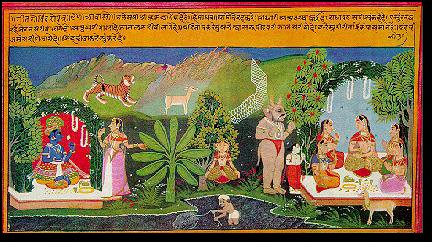The last verse of the prahandha is a befitting culmination of the description of the outer and inner state of Radha. Jayadeva draws a picture of Radha with words that convey oceans of meaning.
Radha's home is a jungle. Her sighs fan her burning pain to flames that rage like the forest fire. She herself is the timid frightened deer, who is trying to flee from the messenger of death; the tiger who is none other than Kama, the god of love.
Jayadeva superimposes the name of the metrical pattern, the sardulavikridita chanda (the metrical pattern called by the name of the tiger) in which the verse is set. An English translation of a highly contextual simile full of literary allusions cannot do justice to the original. However, the syntax and the literal translation become necessary prerequisites for understanding the logic of pictorial format.
The sakhi and Krsna, as the pictorial counterpart of the poetic refrain is easy to understand. But how does one comprehend a hunting tiger, a whining doe, a meditating figure against a flaming tree, or for that matter, the appearance of yet another deer and an explicit fence around what may be a forest or a rock - certainly a wilderness.
The motivational clues for this pictorial composition have to be sought in the imagery and the artist's method of transferring it into a cohesive painting. The wild jungle of her house is the wild jungle of Radha's emotions. She is surrounded by these emotions. The strings of necklaces on Radha and the sakhi is one kind of net or chaining, their sitting around her as if chaining her is another kind of snare or net. The representational net is the enclosure of the forest. It is also the net work of her emotions. Here the phrase malapi jalayate stirs the imagination of the artist. Like the poet, he interprets it with all the variations of the multilayered nuances of the phrase.
As if not satisfied by this, the artist picks on the phrase, "She like a doe frightened by the tiger, who is (none other) the god of love Kama." Ingeniously, a figure of Kama stands with his bow. Immediately behind him stands a proportionately large figure of a human animal (anthropomorphic) who represents death. She, as the frightened deer is represented by the doe who is placed in the foreground against Radha. And lastly the artist takes the phrase "Her sighs fan the flames of her desire." Radha sits in a meditative pose against an aflaming tree. The banana tree divides her and the figures of Krsna and the sakhi. The banana tree is functional, but it also suggests the flames. A diminutive figure of a man in the waters below is waiting as if to cool the fire, and attain salvation.
Compositionally there are four different situations, which are condensed into one pictorial surface. Within each situation is a pictorial representation of the of the poem. The tiger and the doe, Radha and the doe, Kamadeva as the spirit of death, and Radha and the flaming tree are all expressions of Radha's inner state. These are all arranged in a curve. The net and the network is arranged in a different set of semicircular arches. The two sets are then blended together by the landscape, the arched bowers, and the color scheme. Figurative art is used to communicate the concept.
|
